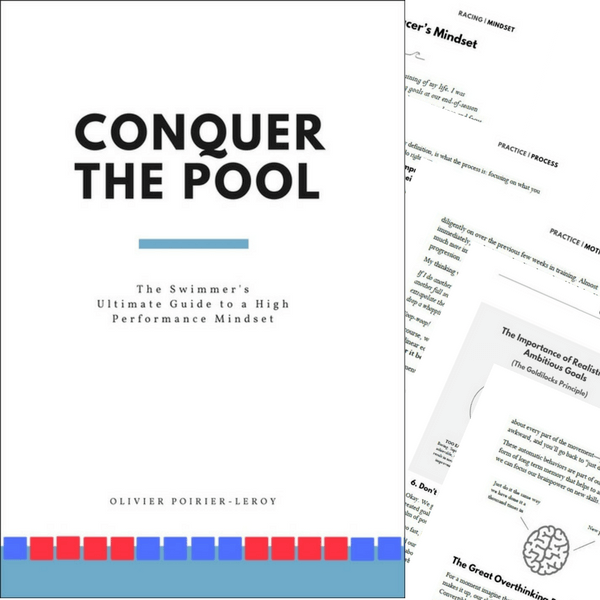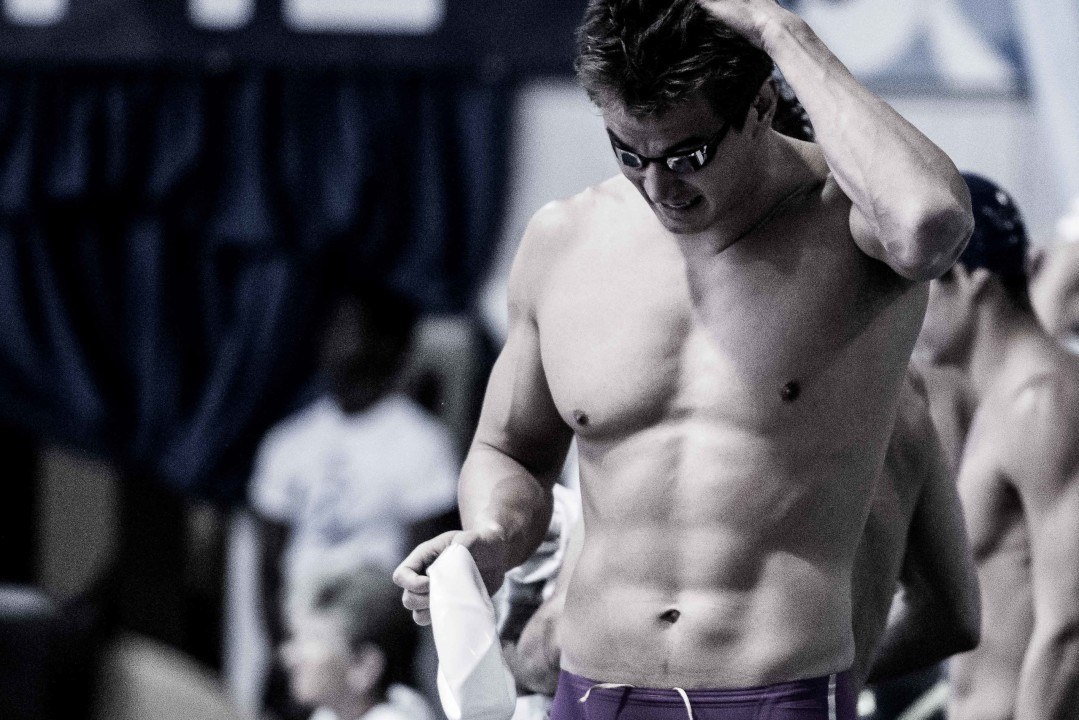Elite swimmers use visualization to help them swim at their maximum at crunch time. Here is how to use this skill for your own swimming goals.
Michael Phelps started doing it at a young age. Adam Peaty relied on it for Olympic gold. Katie Ledecky uses it to help achieve her goals in the pool. It’s a mental training technique called visualization, and it is one of the most potent mental training skills that a swimmer can put in their arsenal.
The process of visualization – or mental imagery — is fairly simple.
You sit down, close your eyes, and essentially daydream about achieving your goal. Doing this consistently helps you “hard-wire” a good performance in your brain, so that when it comes down to race time, you fall back on autopilot, having already swam the race a hundred times in your mind.
Like other mental skills like setting goals for your swimming, visualization is also a fantastic motivational tool; using it consistently helps keep you dialed in on the desired result in the water.
In this guide to visualization for swimmers, we will look at how visualization can help improve performance in training and competition, how it works, and some tips for getting started with visualization.
Let’s dive in.
What is Visualization?
Visualization, or mental imagery, is a mental skill where swimmers create a vivid and detailed scenario in their minds, performing specific skills or achieving a desired result.
Visualization is a tool for improving technique or helping swimmers swim fast under pressure. In training, swimmers can use visualization to sharpen technique, master turns and body position, and swim well under fatigue. In competitive scenarios, visualization is an excellent tool for rehearsals, allowing swimmers to build “reps” of an ideal performance ahead of time.
The versatility of visualization is perhaps its greatest strength. Whether you are looking to become a faster swimmer under pressure or looking to master that early vertical forearm, visualization can help.
Does visualization work?
Visualization is so effective because the brain cannot tell the difference between imagined and real experiences. Research done on weightlifters showed that brain patterns activated during lifting were similarly activated when they visualized themselves lifting weights, with mental rehearsal being nearly as effective as physical practice.
More importantly, the study, titled “From mental power to muscle power—gaining strength by using the mind,” also found that combining visualization with physical practice was more effective than performing either in isolation.
Of course, sitting around visualizing the perfect performance doesn’t replace the necessity of hard work in the pool, but rather, when done in tandem with consistent, intelligent effort during swim training you maximize the chance of swimming out of your mind come meet time.
How to Use Visualization to Swim Faster
Like anything else, using mental imagery is a skill. It’s something best done consistently and habitually. It’s something you use months in advance of the big race, a skill you hone and will eventually master.
Here are some tips for making the most of this skill:
Have a specific outcome.
For swimmers, this is easy. We deal in tenths and hundredths of a second. A time you want to swim. Winning. Whatever the goal, make sure that it is clear as day.
The same goes for using visualization to improve training skills. Are you trying to improve your turn technique, better body position, or a stronger pulling motion?
Be specific about what you are trying to accomplish in the water and channel your concentration during visualization sessions towards that outcome.
Make the outcome positive.
Seems obvious, right? But your brain will wander towards the W.P.O.’s (worst possible outcomes) often at first. Each time this happens, simply take a breath, acknowledge that you let the imagery get away from you, and reset.
The goal of visualization is to help smooth the path towards achieving your goals, so while there are some things that can happen within the mental rehearsal that are maybe not positive (see next point), the overall outcome should be positive.
Imagine yourself calmly dealing with setbacks.
One of the biggest benefits of visualization is that it gives you an opportunity to “practice” adversity!
As much as we want everything to go perfectly at practice or at the big swim meet, challenges and adversity will happen. Mental rehearsing your response to setbacks will help you calmly navigate adversity when it occurs.
“It’s weird because I didn’t really get that nervous during the Olympics. I’d swam that race a thousand times in my head. I’m a big fan of visualization so I’ll always visualize my race beforehand.” — Adam Peaty
A study published in the International Journal of Environmental Research and Public Health, titled “Influence of Imagery Training on Adjusting the Pressure of Fin Swimmers, Improving Sports Performance and Stabilizing Psychological Quality,” with fin swimmers showed that mental imagery reduced anxiety during competition and improve performance.
Visualization is a great way to help swimmers who get flustered with pre-race nerves in competition (i.e. “choke”).
When sitting down to visualize the Big Race, add some hiccups and adversity to prepare you for the pressure of competition.
“When I would visualize, it would be what you want it to be, what you don’t want it to be, what it could be. You are always ready for whatever comes your way.” — Michael Phelps
There are a variety of things that could (and should) go wrong within your mental imagery:
- The car breaks down on the way to the meet.
- You only get a shortened warm up.
- The swimmer beside you bolts out to an early lead.
- Your first race of the meet goes against expectations.
These are all things that you should incorporate into your frequent visualization sessions so that when something does go awry at the meet (and something invariably does!), you will be cool as a cucumber.
When you notice yourself wandering, stop, reset and start again.
The narrow focus required for mental rehearsals can be challenging at first. Be patient, and when you find yourself mentally wandering, stop, reset, and start over.
Especially as you first start out trying visualization you’ll find that your brain will want to play hooky and think about other stuff.
Did so-and-so like my status yet? I wonder if the game is on yet? I wonder how hard practice is going to be tonight?
When your thoughts wander, catch yourself, reset, and start over.
Like any other type of skill or practice, the more you do it, the better you will get at it.
The more details in your visualizations, the better.
The more real the mental image, the more convinced your brain will be that this is real life. Imagine the texture of the block under your feet.
The deep breaths through your nose as you await the starters gun. The background noise of the crowd. The way your hand slices through the water.
From there move to the sensations and feelings you experience over the course of the day. How loose your muscles feel as you warm up. The adrenaline coursing through your blood and butterflies in your tummy in the moments before the race. The elation that washes over you as you touch the wall and look up at the scoreboard.
The more you do it, the better you will get at it!
Mental imagery is a tool, not a last minute patch for insufficient preparation or training. Incorporate it into your daily training, and you’ll find that the visualizations get richer in detail and truer to life.
More Mindset Guides for Swimmers
Winning the mental game is part of race day success in the pool. Here are some more resources for swimmers who want to level up their mindset in the water.
- 8 Ways to Stay Motivated with Your Swimming. Looking for some high-grade motivation to last all season long? Here are some proven strategies for more motivation, more often.
- How to Rebound After a Bad Swim Race. Bad races happen to us all. Here is a game plan for bouncing back after a disappointing swim performance.
ABOUT OLIVIER POIRIER-LEROY
Olivier Poirier-Leroy is a former national-level swimmer, author, swim coach, and certified personal trainer. He’s the author of YourSwimBook, a ten-month logbook for competitive swimmers.
 He’s also the author of the recently published mental training workbook for competitive swimmers, Conquer the Pool: The Swimmer’s Ultimate Guide to a High-Performance Mindset.
He’s also the author of the recently published mental training workbook for competitive swimmers, Conquer the Pool: The Swimmer’s Ultimate Guide to a High-Performance Mindset.
It combines sport psychology research, worksheets, anecdotes, and examples of Olympians past and present to give swimmers everything they need to conquer the mental side of the sport.
Ready to take your mindset to the next level in the pool?
Click here to learn more about Conquer the Pool.
Originally published May 13, 2016. Updated July 14, 2023

I have experienced this too coming into college, however now that I represent a big school that motivates me to swim faster. Maybe you should try to visualize yourself getting amped up for a race that way you are not too calm. The nerves can definitely be used in a positive way as opposed to a negative way
Okay, thanks!
I have a question. I’ve been swimming since I was like three years old and I’m headed into NCAA swimming this fall. In the past year or two, I’ve started running into a problem. I don’t get nervous before I swim anymore. At first it was just normal meets, but now I get behind the blocks for Juniors Nationals or finals at State Championships without any nerves. I feel like because of this, I’m not getting an adrenaline rush. So I was wondering if anyone else has this problem or has a solution.
I noticed in the article it mentions thinking about the butterflies in your stomach when you visualize. Would that fix the problem?
Set higher goals to challenge your nerves – A PB, maybe. Make the goals personal. Then focus on training to achieve this/these goal/s. That will make you nervous.
It’s been near a year since this post was published, but I hope this is of some help or that you’ve discovered more about yourself during that time. I don’t believe having butterflies is a necessity in becoming great at what you do. I actually believe if you don’t get them you’re far better off. Sure butterflies makes people push harder, but in most instances it prevents people achieving their full potential. I believe the calmness should be used to your advantage and seen as an advantage. When you’re on that block, instead of imagining having butterflies (that’s a down grade), imagine everyone else having butterflies and their nervous faces. Smile and think to yourself, I’ve got this. It’s not… Read more »